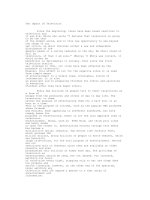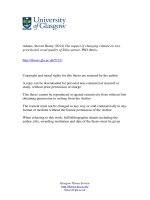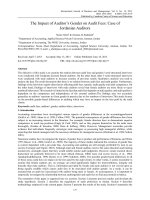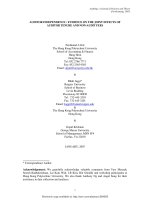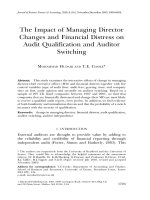abed - 2013 - the impact of auditor’s gender on audit fees - case of jordanian auditors al-badainah
Bạn đang xem bản rút gọn của tài liệu. Xem và tải ngay bản đầy đủ của tài liệu tại đây (140.95 KB, 7 trang )
International Journal of Business and Management; Vol. 8, No. 14; 2013
ISSN 1833-3850 E-ISSN 1833-8119
Published by Canadian Center of Science and Education
127
The Impact of Auditor’s Gender on Audit Fees: Case of
Jordanian Auditors
Suzan Abed
1
& Jomana Al-badainah
2
1
Department of Accounting, Applied Science Private University, Amman, Jordan
2
Department of Accounting, The WISE University, Amman, Jordan
Correspondence: Suzan Abed, Department of Accounting, Applied Science University, Amman, Jordan. Tel:
962-6560-9999-1295. E-mail: or
Received: April 7, 2013 Accepted: May 13, 2013 Online Published: June 18, 2013
doi:10.5539/ijbm.v8n14p127 URL:
Abstract
The objective of this study is to examine the relation between audit fees and gender.5 semi-structured interviews
were conducted with Jordanian licensed female auditors. On the other hand, other 5 semi-structured interviews
were conducted with male auditors to increase scrutiny of previous results. Qualitative analysis was used to
analyse the data.The result documents that there is no relation between audit fees and audit gender. Furthermore,
findings of the interviews report other factors affecting audit fees, namely; audit quality and audit competence. On
the other hand, findings of interviews with male auditors reveal that female auditors are more likely to reject
unethical behaviours.This research is limited to the fact that audit fees depends on audit quality; and audit quality is
dependent on the competence and independence of the external auditors.The findings may not accurately
generalize to auditors’ reactions to client gender in practice due to few numbers of interviews.This study focuses
on the possible gender-based differences in auditing which may have an impact on the fees paid by the audit
clients.
Keywords: audit fees, auditors’ gender, auditor ethics, interviews
1. Introduction
Accounting researchers have investigated various aspects of gender differences in the accountingprofession
(Gold et al., 2009; Almer et al. 1998; Collins 1993). The potential consequences of gender differences have been
subject to an increasing interest in the literature. For example, female directors have to demonstrate superior
competence to reach top positions (Eagly & Carli, 2003), and so they prepare themselves for the tasks more
thoroughly (Fondas & Sassalos, 2000; Huse & Solberg, 2006). However, Management researches provide
evidence that individuals frequently stereotype male managers as possessing high managerial abilities, while
expecting that female managers lack the necessary attributes for managerial success (Heilman et al. 1989; Schein
2001).
Numerous studies have investigated the impact of gender bias in product and performance (Wenneras and Wold,
1997; Basow et al., 2006; Gold et al., 2009). The majority of these studies indicated the existence of gender bias
is context dependent with a pro-male bias. Accounting and auditing are still strongly preferable by men in our
society (Carnegie and Napier, 2010). Although male and female auditors receive the same education and training,
normatively, onemight expect that they would exhibit similar audit judgments. However, extant research shows
thatwomen are generally believed to be more ethical (Mocan, 2008) more risk averse (Levin, et al., 1988;
Jianakoplos&Bernasek, 1998; Byrnes et al. 1999; Schubert, 2006). The possible gender-based differences in all
of these areas could have an impact on the fees paid by the audit clients. In other words, it seems reasonable to
assume that female auditors are, on average, are rated significantly higher for trustworthiness, integrity and
honestly than male auditors. That is, information provided by female and male auditors is not viewed upon as
being equally credible which causes audit fees to be associated with auditor gender. As a result, it can be
assumed that an audit fee isassociated with auditor being male or female. As aconsequence, it is important to
empirically investigate the relationship between auditorgender and audit fees to find any potential evidence.
The remainder of this paper is organized into six sections. Section 2 presents previous studies and develops the
study hypothesis. Section 2 describes the regulations of audit profession in Jordan. Section 4 describes
methodology employed in the current paper. Section 5 presents the results of the study. Section 6 summaries the
www.ccsenet.org/ijbm International Journal of Business and Management Vol. 8, No. 14; 2013
128
main conclusion of the study and provides recommendation for the study.
2. Literature Reviews and Research Question
Auditors add credibility to financial reporting by expressing an opinion about the fairness of the financial
statements. To assure that credible information is purchased, managers use auditor reputation as indicator of
information quality (Chaney and Philipich, 2002). As a result, Deis and Giroux (1992) highlighted that most of
the companies use brand name (Big 4) as a proxy for signaling audit quality differences among audit firm size
group.Choi et al. (2005) mentioned that differences in the level of actual fees across clients are more likely to
reflect the cost of effort perceived by auditor. Thus, a higher audit fees implies higher audit quality either through
more audit effort or through greater expertise of the auditor (Francis, 2004).
Most of previous studies on determinants of audit fees have concentrated on two major categories; clients
attributes which receives more attention in prior studies such as size, risk, complexity of business and
profitability (Simunic, 1980; Stice, 1991; Hackenbrack and Knechel, 1997; Hay et al., 2006). Also, auditor
attributes are considered important drivers of audit fees such as reputation, experience, competition, industry
(Palmrose, 1986; Pearson and Trompeter, 1994; hay et al., 2006 and Gonthier and Schatt, 2007). Based on above,
accounting researches have investigated various aspects of attributes in accounting profession, but all these
studies have not examined the potential gender effects on audit fees. Recently, Hardies et al. (2009) examined the
relationship between auditor gender and audit fees and they found that the female audit engagement partner audit
fees are higher than male counterparts. In the same manner, Khan et al. (1996) found that female auditors are
rated significantly higher than male auditors for their credibility and trustworthiness. Accordingly, Tsui (1996)
pointed out that higher level of ethics is associated with more independent behavior, and it seems sensible to
assume that female auditors are more independent than male auditor. Based on the above, the current study
investigates on the relation between audit fees and gender on Jordanian context.
3. Background of Auditing in Jordan
Audit practice has been covered by Law of Audit Profession 1985 and the Company Law 1997. Article 4 of
Audit Profession 1985 stipulates that in order to be licensed auditor; the auditor must be Jordanian with good
honorable personality and should meet at least one of the following requirements:The auditor should have a PhD
degree in accounting with a minimum one year of experience in auditing; or a master degree in accounting with a
minimum of two years’ experience in auditing; or a bachelor degree in accounting with a minimum of three
years’ experience in auditing; or any holder of professional certificate accredited by professional body such as
AICPA.
The law specifies that auditors should ensure the fairness of the financial statements based on professional
guidelines. Also, law of audit profession has introduced the establishment of audit firms and recommended the
establishment of Jordan Association of Certified Public Accountants (JACPA).
On the other hand, the Company Law 1997 highlighted the main responsibilities of auditors. These
responsibilities include: auditing companies based on International Standards on Auditing (ISA), ensuring the
effectiveness of internal control system in safeguarding the assets of the company and providing an audit report
to the shareholders of the company.
4. Research Methodology
This section discusses the research instrument used in the current study to collect the required data and the
methods that have been employed to analyze the data.
4.1 Research Instrument
Data were collected through semi-structured interviews with female licensed auditors in Amman-Jordan. The
contact information for the interviewed auditors conducted from the website of the Jordan Association of
Certified Public Accountants (JACPA) for the year 2011. The total number of female licensed auditors consists
of 7 auditors from the total of 353 certified professional auditors as listed by JACPA in 2011.The interviews were
carried out in the auditors’ office of 5 (Note 1) female auditors in the period between the 7
th
of November and the
20
th
of November 2012, where each interview lasted up around 45 minutes. Despite the interviews information
such as auditors’ names, offices and other informationwere assured that they are confidential data (Kamla, 2005),
they refused to record their interviews. So the researchers documented the interviews through detailed notes.
For cross validation and increasing scrutiny over the results of the interviews which were conducted with female
auditors. 5 semi-structured interviews were conducted with male auditors selected randomly from auditors listed
at the website of the Jordan Association of Certified Public Accountants (JACPA) for the year 2011. The
www.ccsenet.org/ijbm International Journal of Business and Management Vol. 8, No. 14; 2013
129
interviews were carried out in Amman-Jordan in the period between the 4
th
of January and the 18
th
of January
2013. The interviews lasted up around 30 minutes.
Before conducted semi-structured interviews, interview guide was developed to help the interviewers to cover in
the course of the interview instead of asking a formal schedule of questions to be asked in a set of order. The
interview guide included five main themes were asked to female auditors:
- What are the problems you face when you start your business?
- What is the reaction of clients when they are deal with female auditors?
- Are you prefer hiring female auditor?
- What is the type of your clients?
- Do you charge higher fees regarding auditand non-audit fees than men?
And also the 2 main themes were asked to male auditors:
-What is the relation between audit fees and gender?
-Who violate the rules more male or female?
Interviews were carried out in a friendly and open atmosphere making sure that conducted interviews performed
in conversational way and unbiased manner by asking the questions in a non-directional, leading, or loaded
pattern. Interviews started by explaining the importance of the research and exploring the current situation of
auditing profession in Jordan. Moreover, interviewees were offered to read the details information and the
contact addresses of the researchers were offered for future research queries.
Subsequently, the same research questions were asked to the interviewee in different subsequences and phrasings.
Detailed notes were written down of unique and common elements in the interview allowing the researchers to
reconsider the research questions addressed in the interview guide.
4.2 Analyzing the Data
Before analyzing data, transcribing the data is very important which involve complete written forms of each
interview. At the first Arabic transcripts were prepared afterwards they were translated into English. The
translation from Arabic to English has been double checked to ensure accuracy. The analysis started by giving
each transcript a clear identifiable code. Then, transcripts were analyzed by highlighting substantive statements.
An analysis grid was then developed for each theme discussed during interviews, and used to assign each
statement to a category. The process of selecting quotations was decided carefully by selecting the most
representative with an eye of an honest balance (Gillham, 2000).
Licensed female auditors were targeted in interviews to examine the relation between audit fees and audit gender.
The first impression that the researcher gained was the difficulty in conducting the interview. When contacting
the audit office, employees refused to make any appointment and advised sending the company email explaining:
purpose of the interview, type of questions that will be asked, and reason of choosing the audit office to be part
in the interviews. However, a response has been received from the general manager’s office after two weeks of
sending two follow-up emails and dialing two phone calls and interviews with the general manager was
approved. Furthermore, all of the female auditor interviewee have male partner whether husband, brother or
father. The main job for the partner is to meet customers and provide advices regarding dealing with clients but
audit service is performed by female auditors. However, in each time the interviewers asked question the
interviewee looked at their partner in order to take green light from them before answer any question and they
were very conservative and brief in their answers.
5. Interviews Findings
This section presents the findings of interviews with female and male auditors which were carried out to
investigate on the relation between audit fees and gender.
5.1 Interviews with Female Auditors
The main objective of this study is to determine the relation between audit fees and auditor’s gender. It is
interesting to know how clients whether male or female feel toward female auditors; this is not the attention of
the study. Such a detailed scrutiny clearly cannot be carried out by using numbers, percentages and statistics
(Basit, 2003). However, carrying out interviews in a country such as Jordon provides new insights regarding this
issue to add to the extant literature of various aspects of gender differences in the accounting profession.
www.ccsenet.org/ijbm International Journal of Business and Management Vol. 8, No. 14; 2013
130
5.1.1 Problems
All of the interviewees had faced financial problems when they started their works in the audit offices. But they
gained support from their family members.
5.1.2 Relationship with Clients
All of the interviewees agreed that there is no problem in dealing with clients regardless to their gender whether
male or female. Likewise, some clients prefer dealing with male auditors than females. This justifies the
existence of male partner in audit offices to help in dealing with clients. That is, the role of male partnerarises in
order not to lose auditor’ clients due to differences in cultural practices and religion backgrounds. This interprets
why females were not talking openly in the interviews, especially because of limited number of female auditors
in Amman which makes the probability of covering their names is so easy. This consistent with Tannen (1990)
who highlighted that gender difference may explain why male state they wish female “would make their mind”.
The femine pattern is to use speech to elicit other’s opinions before deciding because women do not value
intrinsic ranking of preferences (Oakes and Hammond, 1995).However, clients’ gender preferences, the audit and
non-audit services are performed by female auditors.
5.1.3 Recruitments of Female Auditors
Interestingly, and although that interviews were conducted with female auditors, recruitment of female auditors
is not preferable by female auditors. This accused by various personal responsibilities of females such as;
maternity leave, childcare, housekeeping… etc. which eliminate her availability and increase her need for early
leave and vacation time. So, male tend to attend longer hours at work whilst females achieve more works in
total.
Also, ethical issues are considering in recruitment. Where females are indeed believed to be more ethical than
men and female auditors are more likely to reject unethical behavior than male auditors. This result is consistent
with social role theory as mentioned by Eagly (1987) and Mocan (2008).
5.1.4 Type of Clients
Most of clients perform audit services by female auditors were related to limited corporation, partnership and
small family business. One of the interviewees performed audit services for limited numbers of corporations.
This result is consistent with previous studies (e.g., Hardies et al., 2010; Marlow and Carter, 2004) who found
that on average female auditors had significant small clients. Furthermore, all the interviewees agreed that they
perform audit services in very high quality and they do follow up for their works in very high standards. This
result is consistent with feminist theory that the admission of female into male-dominated fields will not change
those fields.
5.1.5 Audit Fees Regarding Audit and Non-Audit Services
All of the interviewees were very conservative regarding audit fees, but they agreed that they charge only the
audit fees which were determined by Jordan Association of Certified Public Accountants. This may be partially
interpreted that all of female auditors tried to skip this question. However, the JACPA determines only the
minimum fees of audit services and leaves the right for auditor to determine the suitable fees depends on the size
of audit services.This result is similar to the result achieved by Deis and Giroux (1992) who highlighted that
companies use brand name (Big 4) as a proxy for signaling audit quality and audit fees differences among audit
firm size group; but this result is inconsistent with Khan et al (1996) and Hardies et al. (2009).
Moreover, interviewees were asked about fees charged for non-audit services, some of them replied that they
charge fees similar to male auditors, but in general they have very limited number of non-audit services. This
result is similar to the result achieved by Hardies et al. (2010). On the other hand, one of the interviewees
mentioned that the fees of non-audit fees depend on the type, on the size of the service and on the type of the
client. This can be interpreted by the fact that all female auditors were very conservative during conducting the
interviews and also they might scare from providing information which could be useful for competitors in the
market, even the fact that they were assured that their names and other information disclosed would be kept
confidential.
5.2 Interviews with Male Auditors
Five male auditors were approached to understand the relation between audit fees and gender.
5.2.1 Audit Fees and Gender
All male auditors agreed that there is no relation between audit fees and auditors’ gender. They referred to other
www.ccsenet.org/ijbm International Journal of Business and Management Vol. 8, No. 14; 2013
131
factors that affect audit fees such as experience of auditors, service quality and accuracy that represented by time
saving. This result is consistent with previous studies (e.g., Francis, 2004).
5.2.2 Unethical Behavior
Most of the interviewees approved that female auditors are more likely to reject unacceptable violation of the
Code of Professional Conduct; this result is consistent with previous studies such as (Mocan, 2008). In contrast,
male auditors granted that they are more competence to discover unethical behavior.
6. Conclusion
The objective of this study was to investigate any expected relation between auditors’ gender and audit
fees.Findings of interviews of female and male auditors revealed that there are no differences between audit fees
and gender.Moreover, the results documented that female in general are more likely to refuse any unethical
behavior or any violation of the ethics of professional codes.
Future research could be conducted to examine any potential relation between audit fees and other factors such
as; corporate governance, internal auditing and auditor specialization. Further research is also needed to help
female auditors in understanding the persistent effects of implicit gender stereotypes, since auditing is still
strongly gender-typed in favor of men in our society.
The results of this study should be considered in the context of its inherent limitations. For example, cultural
differences can be observed between different countries through the way in which business is conducted and
what might be acceptable and what is not. Cultural differences are also evidenced through professional
judgments. The secretiveness of some cultures may make it difficult for some audit firms to form or join
international networks or to experience other cultures and share information and experience. More research is
necessary to investigate the obstacles faces female auditors during conducting their jobs. Additionally, the
research sample is relatively small, limited to few number of licensed female and male auditors which affects the
generalizability of the findings of the study.
References
Almer, E. D., Hopper, J. R., & Kaplan, S. E. (1998). The Effect of Diversity-related Attributes on Hiring,
Advancement and Voluntary Turnover Judgments. Accounting Horizons, 12(1), 1-17.
Basit, T. N. (2003). Manual or Electronic? The Role of Coding in Qualitative Data Analysis. Educational
Research, 45(2), 143-154.
Basow, S. A., Phelan, J. E., & Capotosto, L. (2006). Gender Patterns in College Students' Choices of their Best
and Worst Professors. Psychology of Women Quarterly, 30(1), 25-35.
Byrnes, J. P., Miller, D. C., & Schafer, W. D. (1999). Gender Differences in Risk Taking: A Meta-Analysis.
Psychological Bulletin, 125, 367-383.
Chaney, P. K., & Philipich, K. L. (2002). Shredded Reputation: The Cost of Audit Failure. Journal of Accounting
Research, 40(4), 1221-1245.
Choi, J. H., Kim, J. B., Liu, X., & Simunic, D. A. (2005). Audit Pricing, Legal Liability Regimes, and Big 4
Premium: Theory and Cross-Country Evidence. Working Paper, University Of British Columbia.
Collins, K. M. (1993). Stress and Departures from the Public Accounting Profession: A Study of Gender
Differences. Accounting Horizons, 7(1), 29-38.
Carnegie, G. D., & Napier, C. J. (2010). Traditional Accountants and Business Professionals: Portraying the
Accounting Profession after Enron. Accounting, Organizations and Society, 35(1), 360-376.
Deis, D. R. Jr., & Giroux, G. A. (1992). Determinants of Audit Quality in the Public Sector. The Accounting
Review, 67(3), 462-479.
Eagly, A. H. (1987). Six Differences in Social Behavior: A Social-Role Interpretation. Hillsdale (NJ): Lawrence
Erlbaum Associates.
Eagly, A., & Carli, L. (2003). The Female Leadership Advantage: An Evaluation of the Evidence. The
Leadership Quarterly, 14, 807-834.
Fondas, N., & Sassalos, S. (2000). A Different Voice in the Boardroom: how the Presence of Women Directors
Affects Board influence over Management. Global Focus, 12, 13-22.
www.ccsenet.org/ijbm International Journal of Business and Management Vol. 8, No. 14; 2013
132
Francis, J. R. (2004). What do we know about Audit Quality? British Accounting Review, 36(4), 345-368.
Gillham, B. (2000). The Research Interview. Continuum: London.
Gold, A., Hunton, J. E., & Gomaa, M. I. (2009). The Impact of Client and Auditor Gender on Auditors'
Judgments. Accounting Horizons, 23(1), 1-18.
Gonthier, B., & Schatt, A. (2007). Determinants of Audit Fees for French Quoted Firms. Managerial Auditing
Journal, 22(2), 139-160.
Hackenbrack, K., & Knechel, R. (1997). Resource Allocation Decisions in Audit Engagements. Contemporary
Accounting Research, 14(3), 481-99.
Hardies, K., Breesch, D., & Branson, J. (2009). Perceived Audit Quality: The Relationship between Auditor
Gender and audit Fees. University of Brussels, Belgium.
Hardies, K., Breesch, D., & Branson, J. (2010). Female Auditors in Belgium: Striking Figures and Facts.
Accountancy and Bedrijfskunde, 30(4), 15-28.
Hay, D., Knechel, W. R., & Wong, N. (2006). Audit Fees: A Meta-Analysis of the Effect of Supply and Demand
Attributes. Contemporary Accounting Research, 23(1), 141-91.
Heilman, M. E., Block, C., Martell, R., & Simon, M. (1989). Has Anything Changed? Current Characterizations
of Males, Females and Managers. The Journal of Applied Psychology, 74, 935-942.
Huse, M., & Solberg, A. (2006). Gender-related Boardroom Dynamics: How Scandinavian Women Make and
Can Make Contributions on Corporate Boards. Women in Management Review, 21, 113-130.
Jianakoplos, N., & Bernasek, A. (1998). Are Women more Risk Averse? Economic Inquiry, 36, 620-630.
Kamla, R. (2005). Social Accounting in a Selection of Arab Countries: Critical and Postcolonial Perspectives.
Unpublished Doctoral Thesis, Herriot-Watt University.
Khan, Z. U., Chawla, S. K., & Devine, E. A. (1996). Impact of Gender, Race, and Dress on Choice of CPA's.
Journal of Applied Business Research, 13(1), 53-68.
Levin, I., Snyder, M., & Chapman, D. (1988). The Interaction of Experimental and Situational Factors and
Gender in A Simulated Risky Decision-Making Task. Journal of Psychology, 122, 173-181.
Marlow, S., & Carter, S. (2004). Accounting for Change: Professional Status, Gender Disadvantage and
Self-Employment. Women in Management Review, 19(1), 5-17.
Mocan, N. (2008). What Determines Corruption? International Evidence from Microdata. Economic Inquiry,
46(4), 493-510.
Oakes, L. S., & Hammond, T. A. (1995). Biting the Epistemological Hand-Feminist Perspectives on Science and
their Implications for Accounting research. Critical Perspective on Accounting, 6, 49-75.
Palmrose, Z. (1986). Audit Fees and Auditor Size: Further Evidence. Journal of Accounting Research, 24(1),
97-110.
Pearson, T., & Trompeter, G. (1994). Competition in the Market for Audit Services: the Effect of Supplier
Concentration on Audit Fees. Contemporary Accounting Research, 11(1), 115-135.
Tannen, D. (1990). You Just Don't Understand. New York: Random House.
Schein, V. E. (2001). A Global Look at Psychological Barriers to Women's Progress in Management. The Journal
of Social Issues, 57(4), 675-688.
Schubert, R. (2006). Analyzing and Managing Risks – on the Importance of Gender Difference in Risk Attitudes.
Managerial Finance, 32, 706-715.
www.ccsenet.org/ijbm International Journal of Business and Management Vol. 8, No. 14; 2013
133
Simunic, D. A. (1980). The Pricing of Audit Services: Theory and Evidence. Journal of Accounting Research,
Spring, 161-190.
Stice, J. (1991). Using Financial and Market Information to Identify Pre-engagement Factors Associated with
Lawsuits against Auditors. The Accounting Review, 66(3), 516-533.
Tsui, J. S. L. (1996). Auditors' Ethical Reasoning: Some Audit Conflict and Cross Cultural Evidence. The
International Journal of Accounting, 31(1), 121-133.
Wennerås, C., & Wold, A. (1997). Nepotism and Sexism in Peer-review. Nature, 387(6631), 341-344.
Note
Note 1. 2 female auditors cancelled their scheduled interviews due to lack of their interest and time.
Copyrights
Copyright for this article is retained by the author(s), with first publication rights granted to the journal.
This is an open-access article distributed under the terms and conditions of the Creative Commons Attribution
license (

